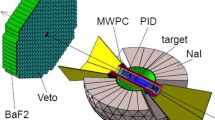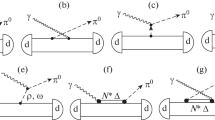Abstract
Double-pion photo-production represents one of the strongest contributions to the photonucleon total cross-section at high energies, and thus it plays an important role in probing the nucleon resonance spectrum. The polarization observables are useful because of the additional sensitivity they provide in unraveling the reaction dynamics, and so the goal of this study is to extract the specific polarization observables \(I^{\odot }\), \(P_{x}\), \(P_{y}\), \(P^{\odot }_{x}\), \(P^{\odot }_{y}\), for the \(\gamma p \rightarrow p \pi ^{+} \pi ^{-}\) reaction. The data were taken as a part of the CLAS g9b (FROST) experiment at Jefferson Laboratory, which used a transversely-polarized target and a circularly-polarized photon beam with energies up to 3 GeV. The data will help deepen the current knowledge of resonance photocouplings and hadronic decays and possibly assist in identifying new baryon resonances via partial-wave analyses and in this way will contribute to a more comprehensive understanding of the strong interaction.
Similar content being viewed by others
References
V. Credé, W. Roberts, Rep. Prog. Phys. 76, 076301 (2013). https://doi.org/10.1088/0034-4885/76/7/076301
W. Roberts, T. Oed, Phys. Rev. C 71, 055201 (2005). https://doi.org/10.1103/PhysRevC.71.055201
S. Strauch et al., Phys. Rev. Lett. 95, 162003 (2005). https://doi.org/10.1103/PhysRevLett.95.162003
D.I. Sober et al., Nucl. Instrum. Method A440, 263 (2000). https://doi.org/10.1016/S0168-9002(99)00784-6
H. Olsen, L.C. Maximon, Phys. Rev. 114, 887 (1959). https://doi.org/10.1103/PhysRev.114.887
C.D. Keith, J. Brock, C. Carlin, S.A. Comer, D. Kashy, J. McAndrew, D.G. Meekins, E. Pasyuk, J.J. Pierce, M.L. Seely, Nucl. Instrum. Method A684, 27 (2012). https://doi.org/10.1016/j.nima.2012.04.067
B.A. Mecking et al., Nucl. Instrum. Method A503, 513 (2003). https://doi.org/10.1016/S0168-9002(03)01001-5
M. Williams, M. Bellis, C.A. Meyer, JINST 4, P10003 (2009). https://doi.org/10.1088/1748-0221/4/10/P10003
A. Fix, H. Arenhövel, Eur. Phys. J. A 25, 115 (2005). https://doi.org/10.1140/epja/i2005-10067-5
L. Roca, Nucl. Phys. A 748, 192 (2005). https://doi.org/10.1016/j.nuclphysa.2004.10.028
Author information
Authors and Affiliations
Consortia
Corresponding author
Additional information
This work is supported in parts by NSF PHY-1505615.
This article belongs to the Topical Collection “NSTAR 2017 - The International Workshop on the Physics of Excited Nucleons”.
Rights and permissions
About this article
Cite this article
Net, L.A., Strauch, S. & For the CLAS Collaboration. Polarization Observables in Double-Charged-Pion Photo-Production with Circularly-Polarized Photons Off Transversely-Polarized Protons. Few-Body Syst 59, 123 (2018). https://doi.org/10.1007/s00601-018-1445-0
Received:
Accepted:
Published:
DOI: https://doi.org/10.1007/s00601-018-1445-0




